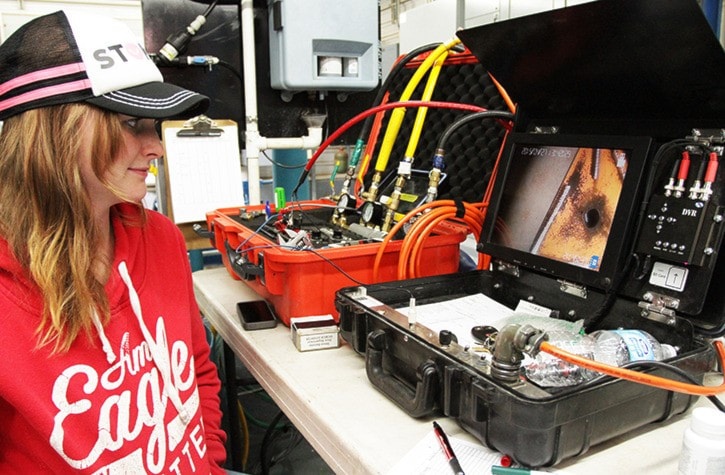Ponoka’s drinking water reservoirs underwent important maintenance last week to ensure the town’s water stays clean.
Aquatech Dive Services was hired to conduct water reservoir cleanup at the Town of Ponoka’s water reservoirs with much of the time being spent at the Lucas Hieghts Pump Station.
The company spent some time Monday, April 27 explaining what it takes to clean the one million gallon tank.
“We’re taking a look at the floor for any cracks, any pop outs. Same with the pillars and the walls,” explained dive supervisor Steve Berube.
While the idea of being a scuba diver brings out the adventurer in a person, Aquatech’s work is really about proper maintenance and cleaning of reservoirs. Their job is assisted with high tech underwater video equipment that gives them and clients a direct look at the infrastructure.
He says cleanup of these reservoirs is important and while the town’s reservoir is relatively clean, he has come across some where the sediment is a couple of feet deep. “We recommend a schedule of every three to five years to have them inspected at least.”
Diver Priscilla Hamilton has been certified as a diver for a year and she says visibility can be minimal if there is a lot of sediment. “It is really easy to get lost in a tank,” said Hamilton.
“You just kind of have to constantly remind yourself which wall you’re up against,” she added.
The only real source of light is from the helmet, which illuminates the way for a diver, who can then track cleanup. “You wouldn’t want to continuously keep changing your direction,” she explained.
Divers go into a tank with full body scuba gear, weighing in at approximately 100 pounds, and a large helmet to allow constant airflow, said Berube. They are able to speak with the dive supervisor and even listen to music while conducting the work, usually for a three-hour stretch.
To ensure no contaminants enter the water, divers’ skin is completely covered and their gear is sanitized before entering a reservoir.
The Lucas Heights reservoir is relatively large measuring in at approximately four metres by 40 metres by 40 metres. The water is about three metres deep, explained Steve Wass, waterworks foreman for the town.
He recently ordered a mixer that will be placed in the middle of the reservoir. Wass says this mixer creates a healthy flow of water that ensures cleaning chemicals do not sit stagnant.
“If you have that stuff in suspension in the water, that’s when you have trouble with your chlorine doing its job,” explained Wass.
Berube said some of the more interesting items he has found in other reservoirs over the years have been bugs, a mouse, a wallet, half of a rifle and a broomstick. Hamilton said she once found a wrench that had to be pried off the floor.
Work on the Lucas Heights reservoir was estimated to take three days.
Clarification: The April 29 edition of Ponoka News on scuba divers cleaning the town’s reservoir on page 29 states a mixer was purchased to ensure cleaning chemicals are properly mixed. To clarify, the only chemical used is chlorine as a disinfectant. We regret the confusion.
